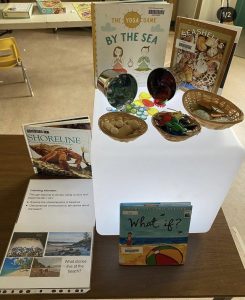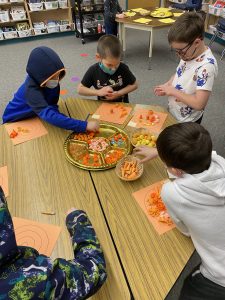I. General Information
School Name: Brechin Elementary
School District: SD#68 Nanaimo-Ladysmith
Inquiry Team Members: Olga Poyner: olga.poyner@sd68.bc.ca, Wendy Robertson: wendy.robertson@sd68.bc.ca, Lisa Brett: lisa.brett@sd68.bc.ca, Tara McConnie: tara.mcconnie@sd68.bc.ca, Andrea Andrews: andrea.andrews@sd68.bc.ca, Meghan Mann: meghan.brasier@sd68.bc.ca, Jodi Crawford: jcrawford@sd68.bc.ca, Brianne Anderson: brianne.anderson@sd68.bc.ca
Inquiry Team Contact Name/Email: Olga Poyner/olga.poyner@sd68.bc.ca
II. Inquiry Project Information
Type of Inquiry: NOIIE
Grade Levels Addressed Through Inquiry: Primary (K-3)
Curricular Areas Addressed:
- Language Arts – Literacy
- Language Arts – Oral Language
- Language Arts – Writing
Focus Addressed:
- First Peoples Principles of Learning
- Flexible learning
- Formative assessment
In one sentence, what was your focus for the year? Using play, loose parts and Story Workshop for supporting oral language and writing.
III. Spirals of Inquiry Details
Scanning: We informally scanned for three students who were emerging, developing and proficient in Language Arts from each of the K-3 classes. We then interviewed them one-on-one using the “Four Questions”. We noticed that students needed support with explaining where they are going with their learning, specifically WHY they are learning it. They were not always able to explain why writing or telling stories was important.
We also realized that students needed lots of support with oral language and oral story telling. We felt this was an important step towards the writing process in our early learners, and this needed to be strengthened first before we ask our students to write.
Focus: We used the curriculum’s Big Idea that all children have a story to tell. We also used the First Peoples Principles of Learning: “Learning takes patience and time.” Our hope was that loose parts and story workshop would give students a multisensory, play-based experience. It could give them time to explore materials and ideas; interact with peers; and the confidence and skills to create stories that are more connected to their personal experiences. We also looked at Story Workshop as a possibility for creating more space for the adults in the room to observe and listen to students and nudge them forward with their oral language and writing.
Hunch: We know that children learn best through play. We also knew that all of these children come to school with stories and experiences that they want to share with others. Offering the loose parts as a playful way to tell their stories was a natural progression towards supporting children’s oral story telling, which we hoped would lead to more motivation to write. Using the “Play Today Continuum” as one of our guides, our hunch was that although we provide our students with lots of child-directed free-play, we may not be giving our students enough opportunities for the more educated-guided playful learning that is often used in Story Workshop. We also had a hunch that we did not have the right materials or infrastructure to support Story Workshop.
New Professional Learning: We participated in the district’s Learning Series on Story Workshop. This workshop provided our teachers with an opportunity to explore a few professional resources and attend some after-school workshops. Some teachers were guided by the “Makerspaces” text by Thompson and Compton, while others chose “Story Workshop” by MacKay, as their mentor text. We worked on the editing process and getting students to continue with their writing over a period of days. We found success with taking photographs and printing them for students so that they can have a concrete memory of their story, which also aided with stretching out the writing process over a number of days. This year we also purchased a photo printer to help us with expediting the printing process.
Taking Action: Each of the classes involved took different approaches to implementing Story Workshop and loose parts. The K/1 class used loose parts as a soft start first thing in the morning, about 3-4 days a week, often taking anywhere from 1 hour to 90 minutes. Students usually sat in their table groups and materials were already set up on the tables for them to play with. Later in the year, as more routines were established, all of the materials were located on a central table in the classroom and students could go “shopping” for the loose parts that they needed to create their stories.
The Gr. 1/2 and 2/3 classes mostly used Story Workshop bins that were created by the Literacy Coordinator and Teacher-Librarian. Each bin contained materials, mentor texts and posed a provocation, often around a theme (e.g., spring, fairy tales, bears). There were about 4-5 bins or “stations” where students could play and work on story creation. Because students were a bit older, there was less in the way of management of students and materials, so this method seemed to work best. This was also convenient for teachers as it required less planning and preparation.

Photo (above): An Example of what is inside our Story Play Bins.
This one is meant for the light table and asks children “What stories live on the beach?

Photo (above): Literacy Week whole school activity where the theme was “Learning in the outdoors”.
We read the picture book “Swirl by Swirl: Spirals in Nature” by Joyce Sidman
to inspire our creations of swirls using loose parts.
Checking: One of the biggest differences we made was increasing the time for children to play, talk and write. This resulted in a greater volume of writing. Children rarely ever had “writer’s block”. It gave us many opportunities to work with students one-on-one and have a focus for each student. We could see where they were at and where they could go next by using a rubric that we had created last year. Photos and writing samples were constantly being collected and growth could be observed and measured using the rubric. In our Story Workshop planning, we made sure to start with clear learning intentions that were also printed out and included in each Story Play bin. We were very satisfied with this and felt that in the Spring interviews, students were able to answer the four questions with less support and prompting.
Reflections/Advice: Two big lessons we learned from this inquiry are:
1) Having clear learning intentions when planning and delivering Story Workshop lessons and clearly stating them, even having them written on the board. This not only focused our students but helped us with our role as guiding educators.
2) Creating ample space and time for the loose parts play. This allowed children the ability to move into the story creation and writing phase of Story Workshop more smoothly and resulted in a motivation to write more.
This was our second year of the NOIIE inquiry and we feel we have established a solid infrastructure for Story Workshop systems. We will continue to use loose parts, the Story Bins and Story Workshop with our K-3’s and continue learning alongside our students.
Our advice to other schools is to take the plunge and try it out! We recommend starting with just a few materials and have a really great mentor text, such as the one’s we previously mentioned. ”
StoryMaking” by Compton and Thompson was a great resource that we used at the beginning of our inquiry, and we highly recommend this if you are brand new to using loose parts and Story Workshop.
We also recommend taking photos if you can. For us, this was just the best way to capture children’s stories, especially at the beginning stages. If you don’t have the option to print them, we have found success in projecting student’s images on the screen so that students can share their stories with the class. They also make great memories for an end of the year slideshow.
Lastly, there is no right or wrong way to do this. You will find that loose parts and Story Workshop look different everywhere you go. Do what works for you and your students!

Photo (above): Each class had a colour theme to choose from to create their swirls,
then their swirls were photographed and printed to create this dazzling collaborative art display.
